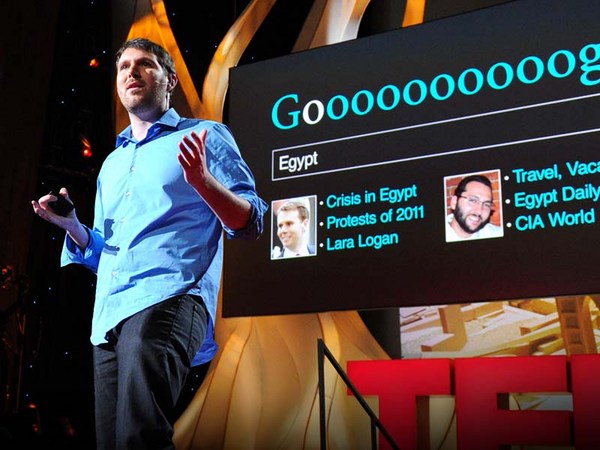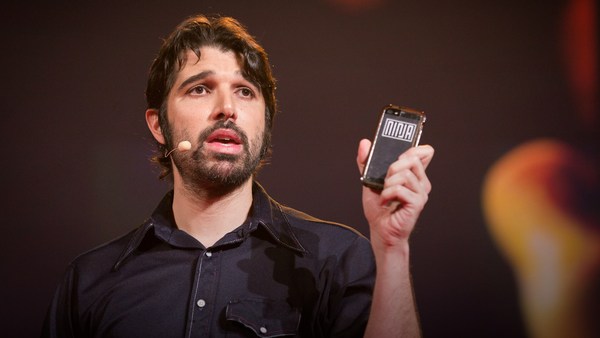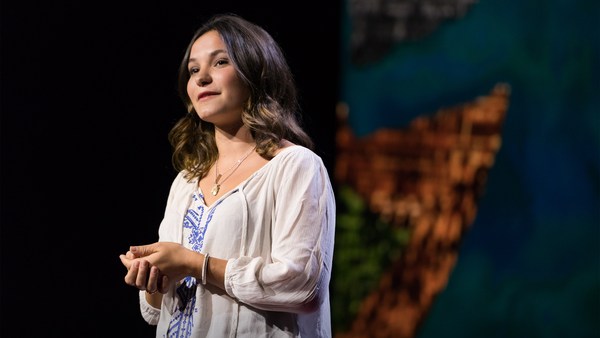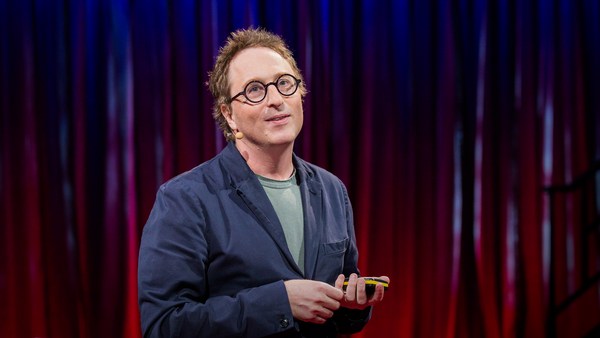I'm here to talk to you about a new way of doing journalism. Some people call this "citizen journalism," other people call it "collaborative journalism." But really, it kind of means this: for the journalists, people like me, it means accepting that you can't know everything, and allowing other people, through technology, to be your eyes and your ears. And for people like you, for other members of the public, it can mean not just being the passive consumers of news, but also coproducing news. And I believe this can be a really empowering process. It can enable ordinary people to hold powerful organizations to account.
So I'm going to explain this to you today with two cases, two stories that I've investigated. And they both involve controversial deaths. And in both cases, the authorities put out an official version of events, which was somewhat misleading. We were able to tell an alternative truth utilizing new technology, utilizing social media, particularly Twitter. Essentially, what I'm talking about here is, as I said, citizen journalism.
So, to take the first case: this is Ian Tomlinson, the man in the foreground. He was a newspaper vendor from London, and on the 1st of April 2009, he died at the G20 protests in London. Now, he had been -- he wasn't a protester, he'd been trying to find his way home from work through the demonstrations. But he didn't get home. He had an encounter with a man behind him, and as you can see, the man behind him has covered his face with a balaclava. And, in fact, he wasn't showing his badge numbers. But I can tell you now, he was PC Simon Harwood, a police officer with London's Metropolitan Police Force. In fact, he belonged to the elite territorial support group. Now, moments after this image was shot, Harwood struck Tomlinson with a baton, and he pushed him to ground, and Tomlinson died moments later.
But that wasn't the story the police wanted us to tell. Initially, through official statements and off-the-record briefings, they said that Ian Tomlinson had died of natural causes. They said that there had been no contact with the police, that there were no marks on his body. In fact, they said that when police tried to resuscitate him, the police medics were impeded from doing so, because protesters were throwing missiles, believed to be bottles, at police. And the result of that were stories like this. I show you this slide, because this was the newspaper that Ian Tomlinson had been selling for 20 years of his life. And if any news organization had an obligation to properly forensically analyze what had been going on, it was the Evening Standard newspaper. But they, like everyone else -- including my news organization -- were misled by the official version of events put out by police. But you can see here, the bottles that were supposedly being thrown at police were turned into bricks by the time they reached this edition of the newspaper. So we were suspicious, and we wanted to see if there was more to the story. We needed to find those protesters you see in the image, but, of course, they had vanished by the time we started investigating. So how do you find the witnesses? This is, for me, where it got really interesting. We turned to the internet.
This is Twitter; you've heard a lot about it today. Essentially, for me, when I began investigating this case, I was completely new to this; I'd signed up two days earlier. I discovered that Twitter was a microblogging site. It enabled me to send out short, 140-character messages. Also, an amazing search facility. But it was a social arena in which other people were gathering with a common motive. And in this case, independently of journalists, people themselves were interrogating exactly what had happened to Ian Tomlinson in his last 30 minutes of life. Individuals like these two guys. They went to Ian Tomlinson's aid after he collapsed. They phoned the ambulance. They didn't see any bottles, they didn't see any bricks. So they were concerned that the stories weren't quite as accurate as police were claiming them to be. And again, through social media, we started encountering individuals with material like this: photographs, evidence. Now, this does not show the attack on Ian Tomlinson, but he appears to be in some distress. Was he drunk? Did he fall over? Did this have anything to do with the police officers next to him? Here he appears to be talking to them. For us, this was enough to investigate further, to dig deeper. The result was putting out stories ourselves.
One of the most amazing things about the internet is: the information that people put out is freely available to anyone, as we all know. That doesn't just go for citizen journalists, or for people putting out messages on Facebook or Twitter. That goes for journalists themselves, people like me. As long as your news is the right side of a paywall, i.e, it's free, anybody can access it. And stories like these, which were questioning the official version of events, which were skeptical in tone, allowed people to realize that we had questions ourselves. They were online magnets. Individuals with material that could help us were drawn toward us by some kind of gravitational force. And after six days, we had managed to track down around 20 witnesses. We've plotted them here on the map.
This is the scene of Ian Tomlinson's death, the Bank of England in London. And each of these witnesses that we plotted on the map, you could click on these small bullet points, and you could hear what they had to say, see their photographic image and at times, see their videographic images as well. But still, at this stage, with witnesses telling us that they'd seen police attack Ian Tomlinson before his death, still, police refused to accept that. There was no official investigation into his death.
And then something changed. I got an email from an investment fund manager in New York. On the day of Ian Tomlinson's death, he'd been in London on business, and he'd taken out his digital camera, and he'd recorded this.
(Video) Narrator: This is the crowd at G20 protest on April the 1st, around 7:20pm. They were on Cornhill, near the Bank of England. This footage will form the basis of a police investigation into the death of this man. Ian Tomlinson was walking through this area, attempting to get home from work.
(People yelling)
We've slowed down the footage to show how it poses serious questions about police conduct. Ian Tomlinson had his back to riot officers and dog handlers and was walking away from them. He had his hands in his pockets. Here the riot officer appears to strike Tomlinson's leg area with a baton. He then lunges at Tomlinson from behind. Tomlinson is propelled forward and hits the floor.
(People yelling)
Paul Lewis: OK. So, shocking stuff. That video wasn't playing too well, but I remember when I first watched the video for myself, I'd been in touch with this investment fund manager in New York, and I had become obsessed with this story. I had spoken to so many people who said they had seen this happen, and the guy on the other end of the phone was saying, "Look, the video shows it." I didn't want to believe him until I saw it for myself. It was two o'clock in the morning, I was there with an IT guy -- the video wasn't coming. Finally, it landed, and I clicked on it. And I realized: this is really something quite significant. Within 15 hours, we put it on our website. The first thing police did was they came to our office -- senior officers came to our office -- and asked us to take the video down. We said no. It would have been too late, anyway, because it had traveled around the world. And the officer in that film, in two days' time, will appear before an inquest jury in London, and they have the power to decide that Ian Tomlinson was unlawfully killed.
So that's the first case; I said two cases today. The second case is this man. Now, like Ian Tomlinson, he was a father, he lived in London. But he was a political refugee from Angola. And six months ago, the British government decided they wanted to return him to Angola; he was a failed asylum seeker. So they booked him a seat on an airline, a flight from Heathrow. Now, the official version of events, the official explanation, of Jimmy Mubenga's death was simply that he'd taken ill. He'd become unwell on the flight, the plane had returned to Heathrow, and then he was transferred to hospital and pronounced dead.
Now, what actually happened to Jimmy Mubenga, the story we were able to tell, my colleague Mathew Taylor and I, was that, actually, three security guards began trying to restrain him in his seat; when was resisting his deportation, they were restraining him in his seat. They placed him in a dangerous hold. It keeps detainees quiet, and he was making a lot of noise. But it can also lead to positional asphyxia, a form of suffocation. So you have to imagine: there were other passengers on the plane, and they could hear him saying, "I can't breathe! I can't breathe! They're killing me!" And then he stopped breathing. So how did we find these passengers? In the case of Ian Tomlinson, the witnesses were still in London. But these passengers, many of them, had returned to Angola. How were we going to find them?
Again, we turned to the internet. We wrote, as I said before, stories -- they're online magnets. The tone of some these stories, journalism professors might frown upon because they were skeptical; they were asking questions, perhaps speculative, maybe the kind of things journalists shouldn't do. But we needed to do it, and we needed to use Twitter also. Here I'm saying an Angolan man dies on a flight. This story could be big; a level of speculation. This next tweet says, "Please RT." That means "please retweet," please pass down the chain. And one of the fascinating things about Twitter is that the pattern of flow of information is unlike anything we've ever seen before. We don't really understand it, but once you let go of a piece of information, it travels like wind. You can't determine where it ends up. But strangely, tweets have an uncanny ability to reach their intended destination. And in this case, it was this man. He says, "I was also there on the BA77" -- that's the flight number -- "And the man was begging for help, and I now feel so guilty that I did nothing."
This was Michael. He was on an Angolan oil field when he sent me this tweet. I was in my office in London. He had concerns about what happened on the flight. He'd gone onto his laptop, he typed in the flight number. He had encountered that tweet, he had encountered our stories. He realized we had an intention to tell a different version of events; we were skeptical. And he contacted me. And this is what Michael said.
(Audio) Michael: I'm pretty sure it'll turn out to be asphyxiation. The last thing we heard the man saying was he couldn't breathe. And you've got three security guards, each one of them looked like 100-kilo plus, bearing down on him, holding him down -- from what I could see, below the seats. What I saw was the three men trying to pull him down below the seats. And all I could see was his head sticking up above the seats, and he was hollering out, you know, "Help me!" He just kept saying, "Help me! Help me!" And then he disappeared below the seats. And you could see the three security guards sitting on top of him from there. For the rest of my life, I'm always going to have that in the back of my mind. Could I have done something? That's going to bother me every time I lay down to go to sleep now. Wow; I didn't get involved because I was scared I might get kicked off the flight and lose my job. If it takes three men to hold a man down, to put him on a flight, one the public is on, that's excessive. OK? If the man died, that right there is excessive.
PL: So that was his interpretation of what had happened on the flight. And Michael was actually one of five witnesses that we eventually managed to track down, most of them, as I said, through the internet, through social media. We could actually place them on the plane, so you could see exactly where they were sat. And I should say at this stage that one really important dimension to all of this for journalists who utilize social media and who utilize citizen journalism is making sure we get our facts correct. Verification is absolutely essential. So in the case of the Ian Tomlinson witnesses, I got them to return to the scene of the death and physically walk me through and tell me exactly what they had seen. That was absolutely essential. In the case of Mubenga, we couldn't do that, but they could send us their boarding passes. And we could interrogate what they were saying and ensure it was consistent with what other passengers were saying, too. The danger in all of this for journalists -- for all of us -- is that we're victims of hoaxes, or that there's deliberate misinformation fed into the public domain. So we have to be careful.
But nobody can deny the power of citizen journalism. When a plane crashes into the Hudson two years ago, and the world finds out about this because a man is on a nearby ferry, and he takes out his iPhone and photographs the image of the plane and sends it around the world -- that's how most people found out initially, in the early minutes and hours, about the plane in the Hudson River.
Now, think of the two biggest news stories of the year. We had the Japanese earthquake and the tsunami. Cast your mind's eye back to the images that you saw on your television screens. They were boats left five miles inland. They were houses being moved along, as if in the sea. Water lifting up inside people's living rooms, supermarkets shaking -- these were images shot by citizen journalists and instantly shared on the internet.
And the other big story of the year: the political crisis, the political earthquake in the Middle East. And it doesn't matter if it was Egypt or Libya or Syria or Yemen. Individuals have managed to overcome the repressive restrictions in those regimes by recording their environment and telling their own stories on the internet. Again, always very difficult to verify, but potentially, a huge layer of accountability. This image -- and I could have shown you any, actually; YouTube is full of them -- This image is of an apparently unarmed protester in Bahrain. And he's being shot by security forces. It doesn't matter if the individual being mistreated, possibly even killed, is in Bahrain or in London. But citizen journalism and this technology has inserted a new layer of accountability into our world, and I think that's a good thing.
So to conclude: the theme of the conference, "Why not?" -- I think for journalists, it's quite simple, really. I mean, why not utilize this technology, which massively broadens the boundaries of what's possible, accept that many of the things that happen in our world now go recorded, and we can obtain that information through social media? That's new for journalists.
The stories I showed you, I don't think we would have been able to investigate 10 years ago, possibly even five years ago. I think there's a very good argument to say that the two deaths, the death of Ian Tomlinson and the death of Jimmy Mubenga, we still today wouldn't know exactly what had happened in those cases. And "Why not?" for people like yourselves? Well, I think that's very simple, too. If you encounter something that you believe is problematic, that disturbs you, that concerns you, an injustice of some kind, something that just doesn't feel quite right, then why not witness it, record it and share it? That process of witnessing, recording and sharing is journalism.
And we can all do it. Thank you.





